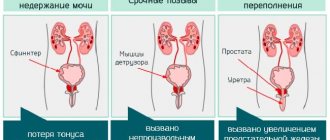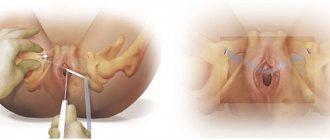Urologist
Mkrtchyan
Karen Gagikovich
13 years of experience
Candidate of Medical Sciences, member of the European Association of Urology and the Russian Society of Oncourologists
Make an appointment
Hydronephrosis is a disease during which the expansion of the pyelocaliceal complex actively progresses. Due to this progression, atrophy of the renal parenchyma may subsequently begin. This consequence develops due to the fact that the stable functioning of the outflow of urine from the kidney is disrupted. Often it makes itself felt, causing severe pain in the lumbar region or painful urination. With hydronephrosis, a pathology such as arterial hypertension can also begin, which can lead to further negative consequences.
At the first pain during urination, it is best to go to the hospital and see a professional doctor so that the disease does not turn out to be advanced. If we look at the diagnosis of hydronephrosis in general, it is often an ultrasound, which is used to check the functioning of the bladder and the functioning of a person’s kidneys. It is possible to cure hydronephrosis, but for this there is a special method - nephrostomy, which will be discussed in more detail later.
In general, hydronephrosis refers to a change in the kidney that occurs due to the fact that the physiological passage of urine is disrupted. As a result, due to such serious disorders, a disease such as hydronephrosis occurs. The cavities of the kidneys begin to rapidly expand pathologically, and the kidney tissue is also subject to changes.
It is worth noting that women often suffer most from the occurrence of this disease. Basically, the disease occurs in adults aged twenty to sixty years. After sixty, the disease can begin to develop in an adult man due to the prostate or prostate cancer. As for women, they suffer from hydronephrosis during pregnancy or due to the development of gynecological cancer.
Nowadays, it is more than possible to treat renal hydronephrosis, especially if you use modern treatment methods, but for this you need to go to a specialized clinic. Using home methods for treating kidney hydronephrosis can only worsen the whole situation. The fact is that hydronephrosis has many stages and a large number of symptoms, which can only be identified by diagnosis.
Modern classification of hydronephrosis
In general, hydronephrosis is divided into:
- primary;
- acquired.
In the first case, this is a congenital disease, which is transmitted to a person genetically, in the second, it is acquired - this is a dynamic method.
Based on the severity of the disease, there is the following classification of hydronephrosis:
- easy;
- moderate;
- heavy.
If we talk about the localization of the disease, it happens:
- unilateral;
- double-sided
It is important to note here that doctors working in the field of urology quite often note that both women and men experience hydronephrosis of both the left and right kidneys, and in some cases, bilateral changes in the human kidneys occur simultaneously.
Hydronephrosis can occur in both acute and chronic forms. The acute form is quite simple and quick to cure using modern techniques. If the form of the disease is chronic, then the kidneys may stop functioning forever even with the best treatment. The disease can develop infected or aseptically.
Hydronephrosis can cause some complications if you turn a blind eye to the fact that a person suffers from similar bladder-related diseases. Due to chronic hydronephrosis, in many cases the first thing that may begin to develop is urolithiasis and pyelonephritis. These diseases have an even more adverse effect on kidney function.
Due to hydronephrosis, kidney failure may begin to appear, especially if both kidneys are affected by the disease, this can lead to death. At any moment, due to impaired water balance or food intoxication, the diseased kidney or both kidneys may fail. The life of a patient with one of these diseases associated with problems with the human bladder can be cut short by a rupture of the sac inside the body. Then urine can spill into the retroperitoneal space and cause critical harm to the entire human body.
The special science of urology and ultrasound can understand that a person is developing hydronephrosis and prevent pathology. A professional doctor will always be able to predict whether a person’s kidney function is in perfect order or what threatens him, so it is best to have it checked periodically at a medical center. It is possible to effectively treat bladder disease if you do not get down to business when it is too late and provide first aid.
Urinary incontinence
Question
I've been having a strange problem lately. Almost every time I sneeze, a small amount of urine comes out and I have no way to control it. I am 23 years old, six months ago I gave birth. Could this be related to this? In general, I heard that this only happens in old age.
Answer
This is called stress urinary incontinence and can happen at any age. Causes: failure of the pelvic floor muscles (either from age or from ruptures during childbirth) and insufficient amounts of female sex hormones. Most likely, you have the first situation. In addition to urinary incontinence, uterine prolapse could also occur from a congenital feature of the ligamentous apparatus, aggravated by childbirth. You need to be examined and decide whether surgery is necessary in your case.
Question
3 months ago I gave birth to a son (first birth). During childbirth, the perineum ruptured and many stitches (external and internal) were applied. After my last examination, my gynecologist said that the stitches had healed well and everything looked great from his point of view. But one problem worries me. My bladder began to leak. And not only when sneezing or blowing your nose (I read this for a while - the norm). I cannot stop the stream while urinating. I run to the toilet every half hour. I can’t do aerobics (it’s especially intense when jumping and running), I can’t leave the house for more than 2 hours - that’s a problem. The gynecologist made an appointment with a specialist, but it was only a month later (queue). Can I do something on my own? And won't this remain a problem for life?
Answer
Indeed, a urologist can help you. Because in order to prescribe treatment it is necessary to find out the cause of the disorder. Depending on this, therapy can be conservative (from physical exercise to local administration of drugs that normalize the function of the urethra) or surgical. Nowadays, you can prepare for your doctor's appointment in such a way as to give him more information for a successful diagnosis and, accordingly, treatment. You should keep a urine diary. In this diary you need to note the amount of liquid you drink (this includes tea, soup, vegetables, and fruits) and urine excreted; the amount of urine passed each time you urinate and each time you experience urinary incontinence.
Question
I have complaints about frequent urination. I noticed that I started noticing this problem after giving birth. In addition, about 6 years ago I had acute cystitis. From time to time, especially in the autumn-winter period, it occurs to me. But even when I'm healthy, I constantly go to the toilet. Several times within one hour and so on throughout the day. There are no painful sensations. Just a feeling of great discomfort due to inconvenience. Could this be some kind of hereditary trait? My mother also suffers from this, although she has a whole bunch of female diseases. In this regard, I am more or less healthy. There are no complaints. Tell me, are there any medications to strengthen the bladder or maybe I can take something as a patient with urinary incontinence.
Answer
The cause of this condition may be injury to the bladder and urethra during childbirth, or weakening of the pelvic floor muscles, which often occurs after pregnancy and childbirth, and as a result, disruption of the location of the bladder and urethra, which leads to urinary incontinence. You need to be examined by a urologist. To find out the causes of your suffering, you will undergo manipulations and tests to determine the functioning of your bladder. Explore its structure. Treatment depends on the results of the examination. In some cases, surgical treatment is required, but conservative therapy is also possible.
Question
Where to go for diagnosis and treatment of bedwetting in an adult woman? Where to begin?
Answer
To clarify your diagnosis and decide on further treatment tactics, you can contact the Department of Urology and Operative Nephrology at the 1st City Clinical Hospital.
Question
I am interested in the following question: After giving birth, I began to suffer from urinary incontinence (nocturnal), that is, enuresis... I was treated with whatever medications! Nothing helps! What to do??? Maybe there are new medications that are more effective...?
Answer
I'm afraid that medications won't help. The cause of urinary incontinence after childbirth is a violation of the position of the urethra, a violation of its innervation. Sometimes special exercises help. Another way to treat this disease is surgical correction.
Question
3 months ago I gave birth to a son (first birth). During childbirth, the perineum ruptured and many stitches (external and internal) were applied. After my last examination, my gynecologist said that the stitches had healed well and everything looked great from his point of view. But one problem worries me. My bladder began to leak. And not only when sneezing or blowing your nose (I read this for a while - the norm). I cannot stop the stream while urinating. I run to the toilet every half hour. I can’t do aerobics (it’s especially intense when jumping and running), I can’t leave the house for more than 2 hours - that’s a problem. The gynecologist made an appointment with a specialist, but it was only a month later (queue). Can I do something on my own? And won't this remain a problem for life?
Answer
Indeed, a urologist can help you. Because in order to prescribe treatment it is necessary to find out the cause of the disorder. Depending on this, therapy can be conservative (from physical exercise to local administration of drugs that normalize the function of the urethra) or surgical. Nowadays, you can prepare for your doctor's appointment in such a way as to give him more information for a successful diagnosis and, accordingly, treatment. You should keep a urine diary. In this diary you need to note the amount of liquid you drink (this includes tea, soup, vegetables, and fruits) and urine excreted; the amount of urine passed each time you urinate and each time you experience urinary incontinence.
Question
At the end of pregnancy, urinary incontinence appeared, and after the birth itself it became even worse. The gynecologist at the maternity hospital advised exercises (squeezing the vagina), but the result was insignificant. It still happens with sudden movements or running. Is it possible that this is a hormonal problem? And which specialist will he contact: a urologist, gynecologist or endocrinologist?
Answer
Problems of urinary incontinence after pregnancy are usually dealt with by gynecologists or urogynecologists. Urinary incontinence has nothing to do with endocrine problems at a young age. Treatment consists of therapeutic exercises (a set of 15-20 exercises), physiotherapy, and sometimes even surgical treatment, because the main cause of such conditions is incompetence of the pelvic floor muscles.
Symptoms, signs of hydronephrosis
It is generally accepted that hydronephrosis manifests itself in a person with various symptoms, since it depends on the location of the hydronephrosis and how quickly the disease associated with the bladder develops. The severity of the disease and the manifestation of symptoms are related to how long the kidney disease lasts. The degree of kidney expansion actively influences the manifestation of the disease. It is important to note that the acute form of hydronephrosis develops quite rapidly and portends a negative outcome if treatment is not started.
During an acute exacerbation, pain in the lumbar region periodically begins to appear in the form of increasing daily attacks. This symptom should make you think about going to the doctor. True symptoms of the disease may also include renal failure, frequent renal colic that spreads through the ureter. Thus, clogging of the urinary canals quickly occurs, which is noted by the science of urology. Colic can spread to the thighs, groin area, perineum or genitals, then both women and men will periodically feel pain in these parts of the body.
List of common symptoms of hydronephrosis:
- frequent urges of the body to go to the toilet and urinate;
- another sign is constant nausea after every meal;
- headache;
- fatigue, irritation;
- gagging;
- Drops of blood may appear in the urine, which can be seen both with the naked eye and by taking a test to a laboratory.
People who struggle with hydronephrosis every day often also report signs of the disease such as high blood pressure and bloating. In addition, patients often develop fever. If we talk about unilateral aseptic chronic hydronephrosis, then most of its time it develops latently. It affects the development of renal failure, pain in the urinary canals. In this case, the bladder experiences discomfort when urinating. The patient may experience constant pain not only in the lower back, but also in the ribs, and with physical activity, all pain in both kidneys intensifies even more.
If the development of hydronephrosis is not stopped, the disease can be fatal, so it is very important to pay attention to all symptoms that appear. People diagnosed with hydronephrosis of the kidneys are not advised to drink a lot of water, as due to increased water balance they may experience symptoms such as kidney pain.
In general, kidney hydronephrosis can also manifest itself as symptoms such as discomfort in the kidneys, insomnia, tingling in the lower back, chronic fatigue, low level of work ability, and hematuria. If a patient with renal hydronephrosis experiences frequent high body temperature, then most likely he is infected. If you experience such symptoms, you should immediately seek help from a doctor. If a person’s kidney is inflamed, then it is necessary to take antibiotics and other medications, but in order to avoid pain in the kidneys later, you need to consult a doctor.
An infected bladder can also manifest its symptoms with hydronephrosis of the kidney, since then the patient feels severe pain when urinating or has problems going to the toilet. It is necessary to pay attention to all the symptoms that the body gives so that there are no problems with the kidney in the future.
Doctors note that when a patient has pain in the bladder, as well as both kidneys, the patient prefers to sleep only on his stomach and cannot change positions. Such symptoms also make you think about the disease. So, to protect the kidney, a person tries to apply pressure and improve the flow of urine. Almost anyone can develop hydronephrosis in the kidney, so you should pay attention to every sign. It is possible to prevent hydronephrosis if you find the cause of the disease and use modern treatment methods. It is worth monitoring your kidneys and doing the necessary tests to check their condition.
Are you experiencing symptoms of hydronephrosis?
Only a doctor can accurately diagnose the disease. Don't delay your consultation - call
Blood in urine - hematuria - microhematuria - macrohematuria
The urine of a healthy person should normally not contain blood impurities, but patients often turn to a urologist specifically with the problem of hematuria - the appearance of blood in the urine.
If the number of blood cells in the urine is so large that a person can independently notice a change in its color, they speak of gross hematuria. Insignificant blood content, which is detected only in urine tests, is called microhematuria.
Regardless of the amount, the appearance of blood in the urine is evidence of the development of a pathological process and requires immediate contact with a urologist.
Causes of blood in urine
There are many diseases that are accompanied by blood getting into the urine. Most often, this condition develops in connection with pathologies of the kidneys, ureters, bladder or urethra. The most common factors for hematuria:
- Infectious diseases.
This factor is more often associated with cystitis and urethritis, which is especially typical for the female body. Often the cause of hematuria is tuberculosis of the kidneys or bladder. - Injuries.
A traumatic factor often causes gross hematuria, as tissue damage and rupture occurs in the kidney, bladder, perineum and urethral bulb. - Urolithiasis disease. Pathology is considered one of the most common causes of microhematuria. Salt calculi (as stones and other formations are called) contribute to the infection and mechanically irritate the mucous membranes of the ureters and urinary tract, which leads to the appearance of blood in the urine.
- Neoplasms.
The most dangerous tumors in this case are bladder or kidney cancer. Oncology may be transitional cell in nature or be a carcinoma or adenocarcinoma. Often in men, the appearance of blood in the urine is a symptom of prostate cancer. It is also impossible not to mention that the cause of hematuria can also be a benign tumor, for example angiomyolipoma, which occurs most often in women during pregnancy and is an accumulation of adipose tissue and blood vessels. - Diseases of the male reproductive system.
Conditions such as prostate adenoma or benign prostatic hyperplasia may well cause hematuria. - Kidney diseases.
This category includes pyelonephritis, glomerulonephritis, renal failure and papillary necrosis.
The factors listed above are only a small part of the pathologies that include hematuria in the list of symptoms.
Diagnosis of the causes of blood in urine
The most effective diagnostic methods used to identify the causes of hematuria:
- laboratory urine analysis: general, bacteriological, cytological;
- cystoscopy;
- intravenous urography;
- Ultrasound of the pelvis;
- computed tomography (CT).
The latter diagnostic method should be treated with caution, as it involves x-ray radiation. And although there is often information on the Internet about the safety of this technique, such statements cannot be taken at face value.
Treatment of blood in urine
Treatment of hematuria is developed strictly individually and is aimed at eliminating the cause of this symptom. Antibiotic therapy is most often prescribed. Pathologies such as neoplasms, urolithiasis, consequences of injuries, etc. suggest surgical intervention.
Purulent discharge in the urine - pyuria
The appearance of pus in the urine is called pyuria. The main cause of the condition is inflammation in the genitourinary system. The severity of pyuria directly characterizes the intensity of the inflammatory process.
A laboratory sign of pyuria is an increased content of leukocytes in the biological fluid (more than 3 million in one unit of volume), while a moderate number of these cells is the norm from a medical point of view. Visually, the patient observes significant cloudiness of the urine and the appearance of light flakes or threads in the sample. If you notice such symptoms, you need to seek help from a urologist as soon as possible.
Causes of pus in urine
Inflammation can be localized in the lower and upper genitourinary tract. In some cases, pus enters the urine as a result of a rupture of an abscess located in nearby internal organs (rare). The most common causes of pus in the urine:
- tuberculosis of the kidneys, genitourinary tract;
- cystitis;
- urethritis;
- acute pyelonephritis;
- prostatitis;
- acute orchitis;
- perforation of purulent formations of internal organs.
These pathologies develop especially actively against the background of reduced immunity, frequent hypothermia, regular overwork and hypovitaminosis.
Forms of pyuria
In the vast majority of cases, a laboratory urine test reveals a combination of pus in the urine with severe bacteriuria (increased bacterial content). If pathogenic microorganisms were not identified during the diagnostic process, they speak of aseptic pyuria, which usually occurs against the background of kidney tuberculosis and dehydration (dehydration) of the patient’s body.
To accurately determine the location of the inflammatory process, urologists use a three-glass urine sample. In this case, the patient is asked to donate urine alternately into three different containers.
Next, the samples are analyzed, which makes it possible to distinguish three forms of pyuria depending on the area of inflammation:
- Initial (initial) form.
If pus is detected only in the first sample, then the inflammatory process is localized in the lower parts of the genitourinary tract, namely in the area of the urethra. - Terminal (final) form.
It is diagnosed when pus is detected only in the last urine sample and indicates the presence of an infectious-inflammatory pathology of the prostate or seminal vesicles in men. - Total (full) form.
The detection of leukocyturia in all patient urine samples indicates a pathology of the renal tissue, most often localized in the area of the renal pelvis or the bladder itself.
Treatment of diseases associated with the appearance of pus in the urine
Treatment of diseases that cause pyuria is determined by their cause and the pathogen that provoked the inflammation. Classic antibiotic therapy is usually supplemented by developing a strict diet, bed rest and drinking plenty of fluids.
If you find an error, please select a piece of text and press Ctrl+Enter
Diagnosis of hydronephrosis
To determine whether a person is suffering from kidney pain, he needs to undergo a special diagnosis before directly starting treatment. First, the doctor needs to collect all the data about the patient and, based on already known information, conduct a physical examination. This method is considered one of the most proven in the field of diagnosis if it is noted that the kidney is in danger and treatment is needed. After the patient successfully passes the physical examination, he will undergo a series of special laboratory tests, as well as some instrumental studies. Typically, all these methods are used in modern diagnostics. To establish an accurate diagnosis for treatment, if the patient has a damaged kidney, professionals at the clinic can perform deep palpation of the abdomen. This determines how stretched the bladder is in an adult or child and whether the kidney is enlarged.
If the patient complains that he periodically feels colic in the abdominal area, then the diagnosis allows catheterization of the bladder. In most cases, many clinics resort to a proven diagnostic method - ultrasound. This is a comprehensive approach by the doctor to understand what he is dealing with; sometimes X-ray contrast studies are also used. Using an x-ray, you can easily determine how the excretory function works with an active kidney.
To check the kidney even more effectively and accurately, doctors resort to urethroscopy and nephroscopy before prescribing direct treatment for the patient. In addition, blood and urine are constantly tested so that the doctor can monitor changes in biochemical parameters.
Causes of hydronephrosis
All doctors name different causes of hydronephrosis, since this disease can occur differently in each person. One of the most common causes of hydronephrosis is the separation of the ureter from the renal pelvis. This happens even in childhood, when the entire structure of organs is disrupted. Another cause of the disease may be a tumor, which in this case should be located at the same level with the ureter and at the same time constantly press on it. Also, the obvious cause of the disease is a fungus, which, if hygiene standards are not followed, can affect the urinary tract.
Doctors actively highlight such a reason as pregnancy in women. Almost every woman on the planet, being pregnant, has suffered from this disease at least once. The obvious causes of the disease are gynecological diseases, since one problem immediately causes another.
Prostate disease in men can cause not only the development of prostatitis, but also hydronephrosis, which will affect and undermine the health of one or two kidneys. Another cause known to many is bladder disease, and there are more than enough variations: from a tumor to an injury.
What is pyelonephritis?
The kidneys have two types of tissues: glomerular and tubulointerstitial. The first filters blood and produces urine, the second collects it and drains it from the kidneys to the ureters and bladder.
Pyelonephritis
called inflammation of the tubulointerstitial tissue of the kidney, namely the calyceal system and renal pelvis, where urine is collected and excreted into the ureters. The inflammatory process can spread below - to the bladder.
The disease can occur in an acute form or in a chronic form with periodic exacerbations.
There are primary pyelonephritis associated with the penetration and proliferation of microorganisms and secondary - caused by a violation of the outflow of urine.
Treatment of hydronephrosis
Hydronephrosis can be cured using various methods. It is only important to find the right individual approach to each patient and prescribe a suitable course of treatment. If you decide on a set of medications, exercises and techniques, you can not only bring the kidney back to life, but also improve its function. The entire course of treatment has several goals - to eliminate all the causes of the development of hydronephrosis, put the human body in order and provide a professional, proper course of treatment. Mostly doctors use conservative or surgical treatment.
As for the first option, this treatment is used only in the first stages of the disease and is rather symptomatic. During this process, doctors use various drugs to relieve pain, inflammation, and fever. If an infection is detected during a diagnostic study, conservative treatment allows the use of antibiotics. If this course does not help, then surgery follows, but taking medications is a mandatory step in the treatment of hydronephrosis.
Very often, surgery is necessary for the patient to fully recover. Then the second part of the treatment course occurs - surgical intervention. It is recommended not to delay and to perform surgery in the early stages of the disease, especially if the patient has been diagnosed with a congenital anomaly.
Doctors treating this disease
As explained above, the field of medicine known as urology deals with the treatment and study of hydronephrosis in detail and professionally. But it is not the urologist who directly deals with the treatment, but the nephrologist. The fact is that for the most part, patients are not dealing with a bladder problem, but directly with poor kidney function. It is the nephrologist who professionally studies such an organ of the human body as the kidneys. A nephrologist diagnoses the disease, gives his recommendations, prescribes prevention of kidney disease and personally carries out treatment, if it concerns his area.
It cannot be said that only a nephrologist can cope with a pathology such as hydronephrosis, since initially the patient visits a general practitioner. In most cases, after the initial appointment, the therapist refers the client to an endocrinologist so that he can make his professional conclusions. If suspicions of a disease are justified, then the person goes to see a urologist and after that a nephrologist begins to deal with his disease.
At JSC “Medicine” (academician Roitberg’s clinic), every patient receives due attention and care, and this applies not only to the medical staff. Each patient will have his own attending physician who deals with his disease, so the list of doctors at the clinic is very large. There is always the opportunity to choose the doctor who is more attractive or has professional skills, for example, in the case of hydronephrosis.
Consequences of urinary retention
Urinary retention causes a general disruption of all processes in the body. As a result, conditions such as:
- loss of appetite;
- attacks of arrhythmia;
- blood pressure surges;
- increased body temperature;
- headache;
- discharge with blood from the urethra;
- nausea and vomiting;
- sleep problems.
If help is not provided in time for acute urinary retention, blood poisoning and bladder rupture may occur. An acute condition refers to urgent pathologies. It is necessary to install a catheter as soon as possible and force urine out.
Common symptoms and manipulations in urology:
- Pain when urinating
- Discharge from the urethra
- Itching in the urethra
- Short frenulum of the foreskin
- Prostate massage
- Prevention of casual sex
- Frenum plastic surgery
- Circumcision
- Kidney pain
- Perineal pain
- Stones in the kidneys
- Pus in urine
- Catheter removal at home
- Bougienage of the urethra
- Urinary retention
- Urological examination
- Papillomas on the foreskin
- erectile disfunction
- Make an appointment with a urologist
Indications
In order for the disease to disappear faster, many doctors highlight the following indications: it is necessary to visit a urologist annually to identify possible pathologies at an early stage; ultrasound of the kidneys is a mandatory indication. It is ultrasound that can provide accurate data about what is happening with the kidneys in the human body. It is best to periodically carry out the prevention of bladder disease.
In addition, people should not forget about maintaining a healthy lifestyle and proper nutrition. All this is interconnected, since due to a large amount of salty, fatty foods and alcohol, not only the liver, but also the kidneys suffer. If a person does not monitor his health, then it is quite possible that already in his youth he will begin to suffer from pathologies.
Risk factors
Many people have a predisposition to strangury due to physiology and lifestyle, hormonal changes or abnormalities in organ function. Difficulties with urination are typical primarily for men, especially those over 45 years of age.
People with congenital anomalies of the bladder, urethra and kidneys are also at risk. Difficulty passing urine is one of the possible consequences of operated hydronephrosis.
Additional risk factors:
- endocrine pathologies that cause disturbances in the urinary system;
- psycho-emotional disorders, depressive states, stress;
- drug use, smoking.
People with a predisposition to strangury need prevention of diseases of the excretory system.
Contraindications
With hydronephrosis, doctors also identify some contraindications that should not be forgotten, since the effectiveness of the patient’s treatment depends on this.
There are the following contraindications for hydronephrosis:
- the patient should not engage in strenuous sports or physically exert himself at all;
- It is better not to ride a horse, ride a bicycle or motorcycle;
- in no case should you engage in self-medication and traditional medicine;
- without a doctor’s prescription, you cannot reduce or increase the dose of painkillers, antipyretics, or anti-inflammatory medications;
- You should give up junk food and go on a special diet, because everything fatty, salty, and spicy is contraindicated.
Cost of initial appointment, research, treatment
It is impossible to name the exact cost of the entire course of treatment for hydronephrosis in the clinic or the initial diagnosis. All this depends on which specialist will work with the patient, as well as what techniques will be used during recovery. The medical center primarily uses only modern innovative equipment. The same applies to medications that speed up the process of recovery. Consequently, even the initial appointment is individual for each client, which is why the price will be different. To have at least the slightest idea of how much treatment at the clinic will cost, you can familiarize yourself with the pricing table.
Advantages of treatment at the clinic of JSC "Medicine"
Clinic JSC "Medicine" is a professional medical center that provides services at the highest global level. Each patient will receive effective treatment, constant care and attention from the medical staff. In addition, the clinic employs professionals with many years of experience who will never make even the slightest mistake. You can trust our clinic with your health. Every new patient can expect modern, clean rooms, good nutrition and the best innovative equipment that can quickly get you back on your feet.











